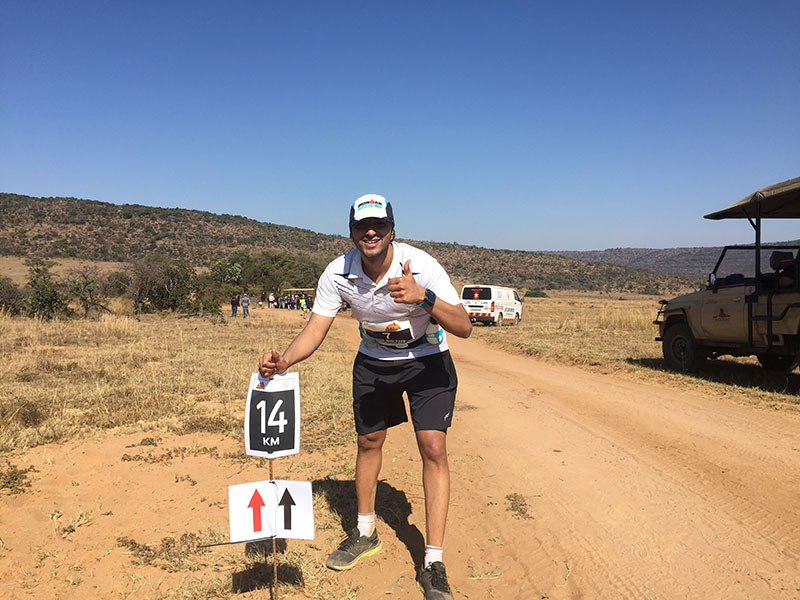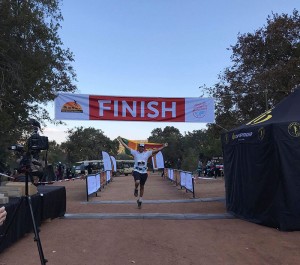
Hassan Esufally – the first Sri Lankan to complete the ‘Big 5 Marathon’ – a 42 km run across the wilds of South Africa
Hassan Esufally, one of Sri Lanka’s leading marathoners recently took on the ambitious mission of earning the prestigious and highly coveted 7 Continents Marathon Club membership. The challenging endeavour requires him to complete some of the world’s toughest and most exclusive marathons across all seven continents. Having completed marathons in Europe, North America, Asia and Australia, Esufally recently ran his first-ever marathon in Africa. Here’s what he had to say about his unforgettable experience running the ‘Big 5 Marathon’ – a tough 42 km run across the vast deserts, hills and savannahs of the wilds of the South African bush:
Q. In a nutshell, tell us about your experience in South Africa and what it felt like to be out there representing Sri Lanka?
A. In a nutshell, this marathon was definitely one of the most memorable ones I’ve ever run! The beautiful scenery and incredible wildlife combined with the warmth and hospitality of the South African people made it all the more exciting and special. It was also a great honour to be out there representing my country. Running past that finish line with the Sri Lankan flag hoisted high above my shoulders was a profound and exhilarating moment, and it gave me a fresh burst of motivation to keep pushing my boundaries in the upcoming marathons.
Q. Take us through the terrain and different stages of the marathon that you ran?
A. In the first 5 km, we had to run up and down a really steep hill, and at this point, I remember thinking to myself ‘man, this is going to be a tough race.’ The 5-18 km stretch was by far my favourite part of the marathon, as it was a more relaxed run on flat, scenic terrain with a fantastic variety of wildlife. The 18-30 km stretch proved to be the hardest part of the race – the terrain changed dramatically and we found ourselves instantly transitioning from dirt track to sand that was ankle-deep, it was like running on a beach with extremely soft sand and looking back I’m really glad that I trained with sand bags. During the 18 km part of the race, I met this group of South African dancers along the way who were singing and dancing so I decided to join them for about two minutes to help get my mind off the pain. It was at this point I switched from having gels and electrolytes to having cola, water and bananas – a strategy that helped very much during the Ironman.
After this came a torturous 4 km climb at a whopping 45 degree inclination! There was also a change in surface again from sand to asphalt, which made it difficult for me to adjust my running style. Taking 14 minutes to cover a kilometre, this was the slowest part of the marathon for me and I later joked with my wife that I slowly made it up the hill like a tortoise and almost sadistically there was a huge ‘Welcome’ sign at the bottom of the hill. The next 30-40 km section was extremely undulating with a lot of ascents and descents. There was however a lot more uphill than downhill and the gradual climb and increasing altitude made breathing a little difficult. The final 40-42.2km stretch took us back onto dirt track, but this time, with a lot of rocks scattered en-route that made it hard to find the right footing at times.
Q. Tell us a little bit about the unique experiences and encounters that you had along the way?
A. Running amidst a fantastic variety of wildlife, just roaming about nonchalantly was definitely one of my favourite highlights. Running through the Entabeni Savannah, I could see rhino, giraffe, zebra and wilder beast, at which point I thought to myself ‘thank goodness – no lions!’ Huge credit goes to the rangers who were tracking the lions all throughout the race, ensuring that they kept a distance of at least 5km from the marathoners. Seeing the animals up-close like that was an amazing experience, and it gave me an adrenaline rush which made me run much faster. I stopped occasionally to take a few pictures of the scenery and wildlife, as this marathon to me, personally, was more about the experience than the finishing time. At many points of the race and at the aid stations, we were also cheered on by traditional African drummers and singers, which made the experience so unique and authentic. There was something special about running to the beat of African drums, in stretches of pure, untainted wild bushland.
Q. What was unique about this marathon in comparison to the others that you have run? What helped you to get through the toughest parts of the run?
A. From the get-go to the finish line, I would have to say that the route and varying terrain, as well as the intense heat all made this marathon quite challenging in its own right. Each continent that I’ve completed a marathon on so far, however does have its own set of challenges and weather conditions that you have to adapt to. That being said, this was definitely the most fun, beautiful and amazing run that I have completed.
Many months of training and my previous experience running long distance marathons in extreme conditions, helped me in some capacity to prepare for this marathon. However, when I was out there in the bush, trying my best to keep going, it was my wife’s incredible support that helped me on. I remember looking up at the 14km mark and seeing my wife cheering me on in the spectator area, I saw her again at the 28km mark and seeing her there cheering me on, gave me the strength and encouragement that I needed to push through the pain I was in and persevere through the toughest stretches of the race. She has always been my biggest supporter and that has made all the difference for me during the toughest of runs.







